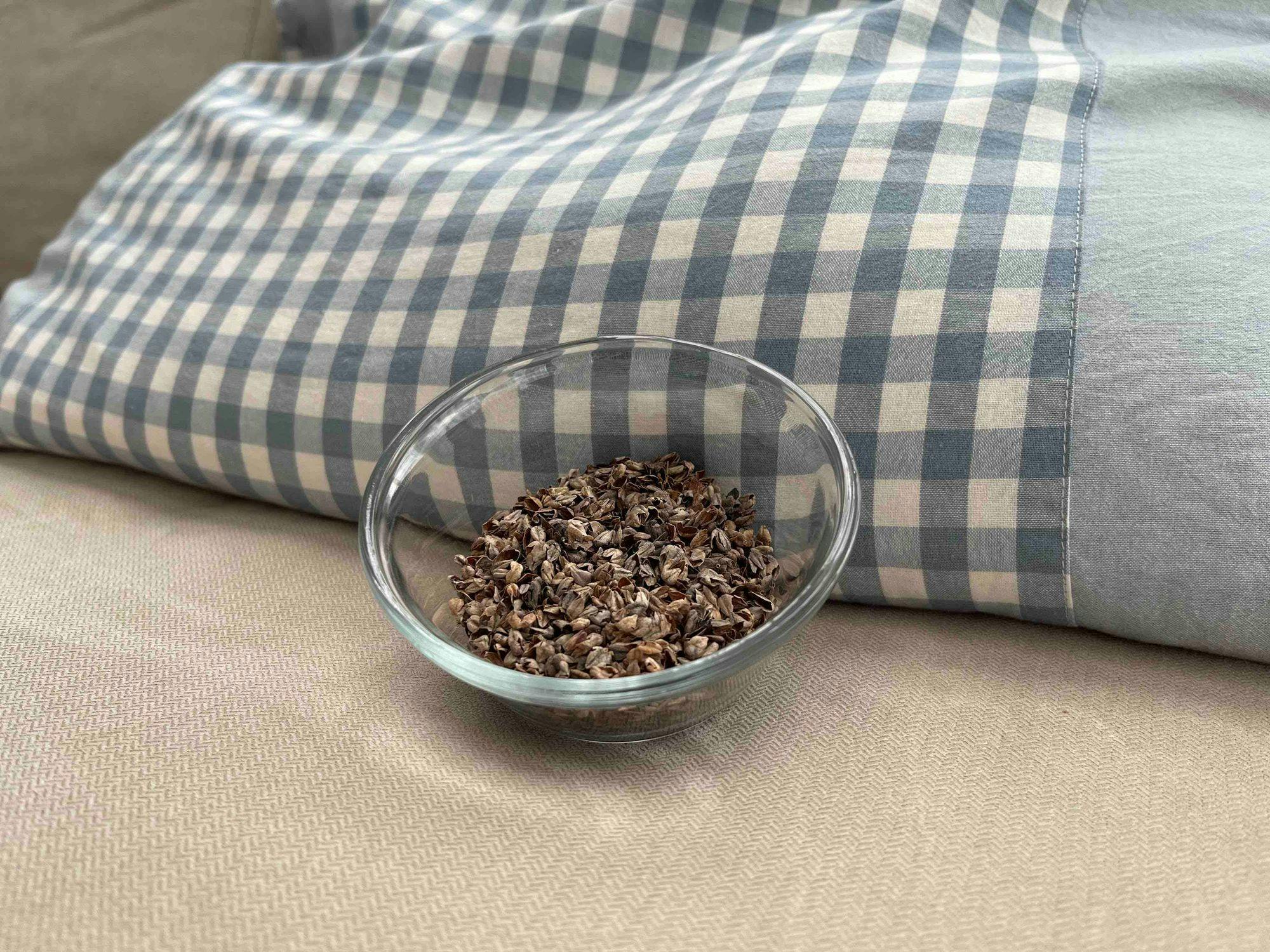Buckwheat pillows are known for offering numerous benefits, such as spinal alignment and snore reduction.
But their hypoallergenic status is not always clear-cut. This raises an important question for allergy sufferers: are they safe to use?
This article discusses whether the natural composition of buckwheat pillows could potentially trigger allergies. We'll explore their materials, potential allergens, and what this means for those with sensitivities.
Key Takeaways
- Buckwheat pillows can be considered hypoallergenic due to their natural resistance to common allergens.
- It's crucial to be mindful of personal allergies and maintain the cleanliness of the pillow to ensure it remains hypoallergenic over time.
Understanding Buckwheat Pillows
We will examine the composition of buckwheat pillows to understand how they can potentially be related to allergies.
Composition of Buckwheat Pillows

Buckwheat pillows are filled with the hulls of buckwheat seeds. These hulls are a byproduct of milling buckwheat, which is used in various food products.
Each pillow contains numerous hulls that conform to the shape of the user's head and neck. This flexibility provides support and can maintain proper alignment during sleep.
The outer shell of a buckwheat pillow is typically made from durable materials such as cotton or bamboo, frequently chosen for their breathability and softness to the touch.
Inside, the buckwheat hulls move independently, which can be adjusted for firmness and loft according to personal preference.
Are Buckwheat Pillows Hypoallergenic?
When we talk about hypoallergenic products, we're referring to items that are less likely to cause allergic reactions.
It's essential for us to understand whether buckwheat pillows fall into this category.
Buckwheat Pillows and Allergens:
- Hulls: Buckwheat pillows are filled with buckwheat hulls, which are the hard outer shells that house the buckwheat kernels. These hulls are naturally hypoallergenic.
- Dust Mites: One significant advantage is that buckwheat pillows tend to resist dust mites, common allergens found in traditional pillows.
- Maintenance: To maintain their hypoallergenic properties, it is advisable to regularly clean your buckwheat pillow by removing the hulls and washing the casing.
Potential Allergic Reactions:
- Buckwheat Allergies: While rare, some individuals may have an allergy to buckwheat. If you're aware of such an allergy, it's important to avoid these pillows.
- Dust: Through regular usage, dust can accumulate within the pillow. Individuals sensitive to dust will need to clean their pillows more frequently.
Table Summarizing Hypoallergenic Properties:
| Feature | Hypoallergenic Benefit |
|---|---|
| Buckwheat Hulls | Natural resistance to allergens |
| Resistance to Dust Mites | Less likely to harbor dust mites |
| Ease of Maintenance | Removable hulls for cleaning |
Allergenic Potential of Buckwheat
We often consider buckwheat pillows as a natural and hypoallergenic alternative to traditional feather or down pillows.
However, there are specific allergens associated with buckwheat, and they can affect individuals who are sensitive.
Buckwheat Hull Allergens
Buckwheat pillows are stuffed with the hulls of buckwheat seeds. These hulls can contain potential allergens that might trigger reactions in some individuals.
Specifically, the proteins found in buckwheat hulls can lead to IgE-mediated allergies, including symptoms such as itching or swelling.
In cases where an individual has a known allergy to buckwheat, exposure through pillows may exacerbate allergic symptoms.
This may possibly lead to more severe reactions, such as difficulty breathing or anaphylaxis.
Dust Mite Allergies and Buckwheat Pillows
Dust mites are common allergens that thrive in warm, humid environments, such as bedding.
Buckwheat pillows are often recognized for their breathable properties which could help reduce moisture retention. This leads to lower chances of dust mite proliferation.
While no pillow can be completely dust-mite proof, the structure of buckwheat hulls may be less hospitable to dust mites compared to other types of pillow fillings.
Overall buckwheat pillow offers an advantage for individuals sensitive to dust mites.
Symptoms of Buckwheat Pillow Allergies
We must be aware that even hypoallergenic items like buckwheat pillows can trigger allergic reactions, particularly in individuals with known sensitivities to buckwheat.
Respiratory Symptoms
Exposure to buckwheat pillows has been associated with various respiratory symptoms.
People might experience:
- Asthma
- Worsening of allergic rhinitis
- An itchy or scratchy throat
- Difficulty breathing
It is essential to recognize these symptoms early and seek medical advice if they occur.
Skin Reactions
Skin reactions may vary widely and can include:
- Hives or rashes, which may appear around the mouth or other areas that come into contact with the pillow
- Itchy or swollen skin, compelling us to further inspect the cause
Our vigilance is key when using buckwheat pillows for those who are prone to allergies.
Mitigating Allergy Risks
When considering buckwheat pillows, it's important for us to address potential allergy risks and implement strategies to reduce them.
Proper Pillow Maintenance
We should regularly clean our buckwheat pillows to minimize allergen accumulation. Cleaning the pillow surface every month helps remove dust and potential allergens.
Additionally, the buckwheat hulls can be replaced every year to ensure the pillow remains as free from allergens as possible.
Hypoallergenic Pillow Cases
Investing in hypoallergenic pillowcases is a proactive step in allergy risk management.
These cases are designed to act as a barrier against dust mites and other common allergens.
We should select cases that are tightly woven and are made from materials less likely to provoke allergies.
Alternative Pillow Options
When considering a switch from buckwheat pillows due to allergies, we can explore several other pillow materials that might be more suitable.
Here, we've listed some common pillow materials that can be hypoallergenic alternatives:
- Memory Foam: Many memory foam are treated to be resistant to dust mites and other allergens.
- Latex: Made from the sap of rubber trees and is inherently resistant to dust mites and mould. A good choice for support and durability.
- Synthetic Down: Aims to mimic the feel of down without using animal products. It is often washable and less likely to harbor allergens.
- Polyester Fill: Can be hypoallergenic and is often more affordable. However, they may not offer the same level of support or longevity as memory foam or latex.
- Cotton: Natural cotton is breathable and can be less hospitable to dust mites, provided it is regularly cleaned.
Here's a comparative glance at the features:
| Material | Hypoallergenic | Support Level | Durability |
|---|---|---|---|
| Buckwheat | High | High | High |
| Memory foam | High | High | Moderate |
| Latex | High | High | High |
| Synthetic Down | Moderate | Moderate | Moderate |
| Polyester Fill | Variable | Low to moderate | Low to moderate |
| Cotton | Moderate | Moderate | Moderate |
Each material offers distinct characteristics and qualities. Factors such as personal comfort preferences, support needs, and budget play key roles in our selection process.
It's essential for us to ensure that the chosen pillow aligns well with individual health requirements and sleep habits.
YZ Li
YZ, an engineer with a PhD based in the San Francisco Bay Area, brings practical expertise to Restful Guides. Focused on simple, effective ways to improve sleep and relaxation, YZ offers easy-to-follow advice on choosing the right pillows, bedding, and meditation techniques for a better, more restful life.

